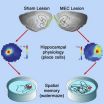(Press-News.org) An international research team led by Dan Distel, director of the Ocean Genome Legacy Center of New England Biolabs at Northeastern University, has discovered a novel digestive strategy in shipworms. The breakthrough, the researchers say, may also be a game-changer for the industrial production of clean biofuels.
To start, it's important to note that shipworms, the so-called "termites of the sea," aren't actually worms--they're bizarre clams that look like worms. Similar to termites, they use enzymes made by bacteria to aid in the break down wood for nutrition. But the researchers found that the enzymes shipworms use to break down wood don't originate in gut bacteria; in fact, they're far removed from it, instead the enzymes are made by symbiotic bacteria stored inside specialized cells in their the gills and then transported to the gut.
Their research was published online Monday afternoon in the Early Edition of the journal Proceedings of the National Academy of Sciences. Distel collaborated with researchers at institutions across the United States as well as in France and the Philippines. The National Science Foundation, the U.S. Department of Energy's Joint Genome Institute, the Fogarty International Center at the National Institutes of Health, and New England BioLabs supported this research.
Distel, a research professor at Northeastern's Marine Science Center, said no other animal in the world relies on bacteria outside of its digestive system to produce its digestive enzymes and no other intracellular bacterium is known to produce enzymes that function in the outside world of the host. In fact, he said digestive strategies don't differ much between organisms, particularly those that eat wood or plant material.
"You don't hear about the discovery of new digestive strategies very often," he said. "It just doesn't happen."
The research team, which included former OGL research scientists Roberta O'Connor (Tufts Medical Center), Jennifer Fung (Bolt Threads Inc.), and Koty Sharp (Eckerd College), examined shipworms from Puget Sound in northwestern Washington. First, the researchers used genomics to sequence the genomes of the gill bacteria and to identify the genes predicted to be involved in breaking down plant matter. Then, they searched the gut in hopes of finding proteins there that were encoded in genomes of the gill bacteria. From their examination, the researchers did in fact find these proteins.
What's more, Distel said the team found nearly 1,000 different genes in the gills that could be involved in breaking down wood. In the gut, they found about 45 of these same genes. "This was a key finding," he said, "because we can identify the small number of enzymes that are actually involved in breaking down wood in gut, and that gives us a list of candidates that you can start to look at to find commercially-viable enzymes."
Distel said a key area where this work could yield potential commercial benefits is in biofuel production. These enzymes, he said, are interesting because they convert plant biomass, or cellulose, into sugar, which can be used to make biofuels like ethanol. The U.S. government has mandated that 36 billion gallons of cellulosic biofuel be produced annually by 2022, and Distel said nearly half of this supply will be expected to come from cellulosic feedstocks--mainly agricultural waste like cornstalks. The USDA estimates that as much as one-third of America's transportation fuel demand could be met by cellulosic biomass. But Distel said the main bottleneck preventing the commercial success of cellulosic ethanol is the lack of enzymes necessary to cheaply and efficiently convert cellulose to sugar.
Enter the shipworm.
In terms of next steps, the researchers plan to investigate exactly how these important digestive enzymes are transported from shipworms' gills to the gut.
Distel also oversees the Ocean Genome Legacy, a public biorepository of DNA samples from marine life that re-located last year to Northeastern's Marine Science Center in Nahant, Massachusetts. He said these findings further exemplify the need to study marine life and its many mysteries.
"This is why it's so important that we as researchers look at oceans," Distel said. "It yields so many unexpected benefits."
INFORMATION:
WASHINGTON - Hospital workers who deal directly with patients wash their hands less frequently as their workday progresses, probably because the demands of the job deplete the mental reserves they need to follow rules, according to new research published by the American Psychological Association.
Researchers led by Hengchen Dai, a PhD candidate at the University of Pennsylvania, looked at three years of hand-washing data from 4,157 caregivers in 35 U.S. hospitals. They found that "hand-washing compliance rates" dropped by an average of 8.7 percentage points from the beginning ...
The Assyrian Empire once dominated the ancient Near East. At the start of the 7th century BC, it was a mighty military machine and the largest empire the Old World had yet seen. But then, before the century was out, it had collapsed. Why? An international study now offers two new factors as possible contributors to the empire's sudden demise - overpopulation and drought.
Adam Schneider of the University of California, San Diego and Selim Adalı of Koç University in Istanbul, Turkey, have just published evidence for their novel claim.
"As far as we know, ...
Results of a federally-funded pooled analysis of five prospective cohort studies indicate that cigarette smoking prior to the first diagnosis of lung (stage I), bladder, kidney or head and neck cancer increases risk of developing a second smoking-associated cancer. This is the largest study to date exploring risk of second cancers among current smokers.
An analysis of five large, prospective cohort studies indicates that lung (stage I), bladder, kidney and head and neck cancer survivors who smoked 20 or more cigarettes a day prior to their cancer diagnoses have an up ...
Nestled among a triplet of young galaxies more than 12.5 billion light-years away is a cosmic powerhouse: a galaxy that is producing stars nearly 1,000 times faster than our own Milky Way. This energetic starburst galaxy, known as AzTEC-3, together with its gang of calmer galaxies may represent the best evidence yet that large galaxies grow from the merger of smaller ones in the early Universe, a process known as hierarchical merging.
An international team of astronomers observed these remarkable objects with the Atacama Large Millimeter/submillimeter Array (ALMA).
"The ...
VIDEO:
Dartmouth researchers say lung cancer screening in the National Lung Screening Trial meets a commonly accepted standard for cost effectiveness as reported in the Nov. 6 issue of the New...
Click here for more information.
Dartmouth researchers say lung cancer screening in the National Lung Screening Trial (NLST) meets a commonly accepted standard for cost effectiveness as reported in the Nov. 6 issue of the New England Journal of Medicine. This relatively new screening ...
Imagine being able to recognize your car as your own but never being able to remember where you parked it. Researchers at University of California, San Diego School of Medicine have induced this all-too-common human experience - or a close version of it - permanently in rats and from what is observed perhaps derive clues about why strokes and Alzheimer's disease can destroy a person's sense of direction.
The findings are published online in the current issue of Cell Reports.
Grid cells and other specialized nerve cells in the brain, known as "place cells," comprise ...
Cats and humans have shared the same households for at least 9,000 years, but we still know very little about how our feline friends became domesticated. An analysis of the cat genome by researchers at Washington University School of Medicine in St. Louis reveals some surprising clues.
The research appears Nov. 10 in the Proceedings of the National Academy of Sciences Early Edition.
Cats have a relatively recent history of domestication compared with dogs; canines arose from wolves over 30,000 years ago.
"Cats, unlike dogs, are really only semidomesticated," said ...
A massive new University of Colorado Boulder study indicates there is a statistical link between hotter temperatures generated by climate change and the risk of armed conflicts in sub-Saharan Africa.
CU-Boulder Professor John O'Loughlin led a research team that assessed more than 78,000 armed conflicts between 1980 and 2012 in the Sahel region of Africa - a semi-arid belt just south of the Saharan Desert that spans about 3,000 miles and more than a dozen countries from the Atlantic to the Indian oceans.
The team was looking for links between armed conflicts and temperature ...
HOUSTON - (Nov. 10, 2014) - An analysis of more than 100 health insurance plans across Texas offered under the Affordable Care Act (ACA) shows that plans can differ significantly in premium cost and the number of hospitals included in insurance networks. That's just one of the findings of a report released today by the Episcopal Health Foundation and Rice University's Baker Institute for Public Policy.
The report examined "Silver" health insurance plans offered by insurers within the ACA's Marketplace. Texas is divided into 26 different geographic areas, with different ...
Philadelphia, PA, November 10, 2014 - Beta-blockers have been a cornerstone in the treatment of heart attack survivors for more than a quarter of a century. However, many of the data predate contemporary medical therapy such as reperfusion, statins, and antiplatelet agents, and recent data have called the role of beta-blockers into question. Two new studies published in The American Journal of Medicine evaluated the traditional management of these patients after their discharge from the hospital and in the light of changing medical treatment, as well as the impact of the ...



